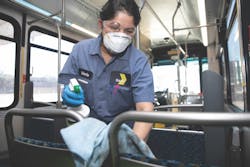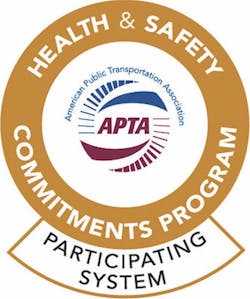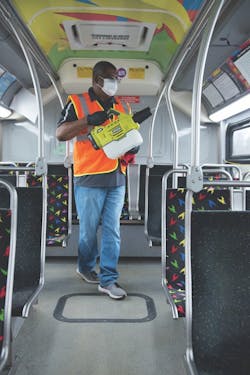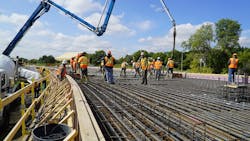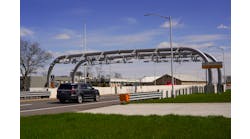By: Paul P. Skoutelas
One year ago this month, Americans rediscovered the vast importance of public transportation. Transit has served as a lifeline for thousands of communities throughout the coronavirus (COVID-19) pandemic, even while local systems lacked necessary funding.
Last week, the industry received its own lifeline—the American Rescue Plan Act—approved by Congress and signed by President Biden to help the nation and public transit recover, reinvest, and restore the promise of a better future.
Beginning in March 2020, the outbreak of COVID-19 in the United States produced profound changes to the American economy, our work, and how we live our daily lives. But as cities and towns were shutting down, our buses, trains, and subways stayed open and served their communities.
Transit delivered front-line workers to essential jobs at hospitals, pharmacies, grocery stores, fire and police stations, and utility companies. We carried passengers to life-sustaining health care services; we transported medicines, meals, PPE, and other critical supplies to at-risk populations. Even if you were hunkered down at home or rarely ever used public transportation, chances are you or a person you know benefited from someone using transit.
What is remarkable is that public transportation agencies have continued to function and serve—for more than a year—despite financial hardship and heartbreaking sacrifices. The pandemic significantly increased operating costs and slashed sources of funding, including fares and other revenues.
In most places, fare collection was suspended for safety reasons. State and local transit funding was diverted to address other COVID-related needs. Our industry was forced to lay-off employees and modify routes. And too many dedicated, courageous transit workers have been sickened or have died from the coronavirus. Our employees have been heroes since the start of the pandemic.
The CARES Act, CRRSAA, and a worsening crisis
Transit agencies, like other public sector organizations and private sector businesses, benefited from the Coronavirus Aid, Relief, and Economic Security (CARES) Act that was approved by Congress last March. In the early weeks of the crisis, our industry used those federal emergency dollars totaling $25 billion to keep the trains and buses rolling, literally.
But as the pandemic spread and the consequences became more dire, additional help was needed. In the ensuing nine months, public transit systems worked diligently to keep people mobile, safe, and healthy. More than 200 transit systems implemented APTA’s Health & Safety Commitments Program, an awareness and education campaign designed to encourage specific practices and policies both by transit leaders and transit users. Extraordinary efforts were put in place to clean, disinfect, and ventilate vehicles and facilities; add or adjust schedules; increase security; install safety equipment; and reduce crowding.
As our work intensified to maintain services where they were needed most and prevent the spread of COVID-19, transit agencies’ costs increased while revenue continued to plummet. By the end of 2020, public transportation agencies and the businesses that support them struggled to function. The numbers showed just how urgent the need was.
- Public transit agencies had already spent or obligated 97% of CARES Act funds.
- More than 6 in 10 transit systems had reduced services, postponed capital projects, and laid off or furloughed workers.
- More than 8 in 10 transit-related businesses—manufacturers, engineering firms, maintenance companies, small business suppliers—reported declines in revenue and had laid off or planned to lay off employees.
In the final days of December 2020, the Coronavirus Response and Relief Supplemental Appropriations Act (CRRSAA) provided some additional emergency funding in the form of $14 billion for public transit and $1 billion for Amtrak. The same Act also increased the annual appropriations for transit investment by almost $50 million above the previous year’s levels. However, CRRSAA fell short of what was needed. It failed to close the ever-widening gap between available funds and our industry’s responsibility to meet growing demands.
The American Rescue Plan Act
After much hard work, the $1.9 trillion American Rescue Plan Act of 2021—the first priority of the Biden Administration—was signed into law last week. It provides $30.5 billion for public transportation and $1.7 billion for Amtrak.
Almost 3 in 4 Americans supported this transit funding because it will help the public transportation industry continue to provide a lifeline to essential workers, ensure Americans can get to vaccination sites, and advance communities’ efforts across the country to rebuild the nation’s economy.
The Act distributes most of the funds through several formula programs:
- $26.09 billion in grants to urbanized areas. The amount made available for these grants, combined with CARES Act and CRRSAA grants, ensures that urbanized areas receive at least 132% of their transit agencies’ 2018 operating costs.
- $317 million in grants to rural areas. States receive allocations of 5-20% of 2018 rural operating costs based on a sliding scale dependent on prior COVID-19 grants.
- $50 million in grants for services targeted to seniors and persons with disabilities.
The new emergency assistance also provides:
- $2.21 billion for operating assistance grants to pay for costs related to operations, personnel, cleaning, sanitization, and debt service payments incurred to maintain operations and avoid layoffs and furloughs.
- $1.675 billion for Capital Investment Grants (CIG) including $1.425 billion for New Start and Core Capacity projects that have an existing Full Funding Grant Agreement (FFGA) and $250 million for Small Start projects.
- $100 million for grants to bus operators and $25 million for planning grants to restore service.
For Amtrak:
- $1.7 billion in grants to prevent, prepare for, and respond to COVID-19, including $970 million for Northeast Corridor grants and $730 million for National Network grants. Moreover, the Northeast Corridor grants include specific funding to take the place of commuter rail payments.
The American Rescue Plan Act does far more than fund public transit’s immediate, emergency needs. It provides a wide array of longer-term financial assistance to workers, employers, schools, restaurants, retail businesses, event organizers, and towns, cities, and states—all of which are essential to the revival of our economy and public transit.
It is important to support transit systems, but people need a reason to use public transportation. Our nation’s economic recovery depends on all citizens having freedom of access to places where they can earn and spend money.
The Future After COVID-19
Crises can create opportunities. The COVID-19 pandemic has elevated public awareness and appreciation for the vital role transit plays in our communities. Today, an overwhelming majority of Americans consider transit to be “an essential public service,” regardless of whether they use it.
With the latest emergency funding soon in hand, public transportation is at a seminal turning point. It’s about a new beginning, not an ending. We must pivot from ensuring survival to planning for success. This will require fresh thinking about how we deliver mobility in a post-pandemic world defined by different travel patterns, preferences, and priorities.
We have an opportunity to strengthen—and in some cases, reinvent—public transit based not only on what we have learned from the global pandemic, but also from the pervasive economic downturn, the accelerating environmental changes in our climate, the need for smart infrastructure investment, and the long-deferred reckoning over racial equity. There is much work to do … on fashioning a new, multiyear authorization law; a national infrastructure initiative; and strategies to ensure access to opportunities and a better quality of life for all.
The public transportation industry has a proud history of surviving crises, embracing transformational change, and emerging stronger and more resilient. The COVID-19 pandemic has severely tested public transit and our nation. Our industry’s ability to emerge successfully from this crisis will have a lasting impact on strengthening public confidence, safeguarding our employees and riders, promoting equity, and investing in a new, more mobile future.
As people reconnect to what they need, love, and aspire to achieve, transit will be there, ready to serve all. After all, freedom and progress have always been driven by mobility.
About The Author: Skoutelas is president and CEO of the American Public Transportation Association (APTA).
